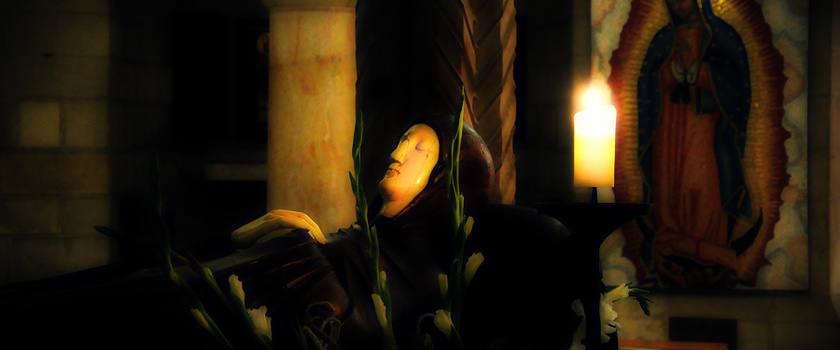Hope in the Ultimate Transfiguration of the Cosmos
15. August 2013
Abbot Gregory, Homily for the Feast of the Assumption (August 15, 2013)
 Crypt of Dormition Church.
Crypt of Dormition Church.
A unique vocation
Today we celebrate once more the mystery of our Lady’s Dormition and Assumption. We call it her “Dormition” or, in Greek, her koimesis, which means her “falling asleep”- a respectful way in which the Early Church described her death. The term “Assumption” refers to the glorification of her body and its resurrection before the Last Day, a unique grace based on her unique vocation as Theotokos, the “God-bearer,” in and through whom the Word became flesh and dwelt amongst us.
These beliefs, firmly held and liturgically celebrated by all the historic pre-Reformation churches, but defined as dogma only in the Roman Catholic Church, are established not by the direct testimony of Scripture but by Tradition, which, as Blessed John Henry Newman suggested, is the Church’s prayerful interpretation of Scripture, leading to the discovery of its deeper meaning through liturgical celebration and theological reflection.
Three aspects of the icon of the feast
The traditional eastern icon of this feast is much loved and for good reasons. Like all Orthodox icons it reveals the meaning of the mystery to those who contemplate it with faith and love. A very good example can be seen in the fresco adorning the western apse of the crypt, here in Dormition Abbey. It would be a worthwhile exercise today, after this liturgy, to spend some moments in prayer before it. Let me comment on three aspects of this icon as an aid to deeper understanding of our Lady’s Dormition and Assumption.
1.
As in all Orthodox icons depicting the mysteries of the faith, Christ our Lord is absolutely central. He appears, glorious in his risen state, to receive the soul of his Mother who has died, and to carry her with him into everlasting life. She whom the Byzantine liturgy names “Mother of the light,” is taken up into glory. It is God’s crowning gift to the one whom he had filled with grace from the first moment of her existence, when he prepared her body to be a fitting temple in which his only-begotten Son could take flesh. Mary’s soul is depicted as a newborn child, wrapped in swaddling bands, for just as she gave birth to him at Bethlehem in the wonder of the incarnation, so in Jerusalem he gave her spiritual birth into eternal life. Yet it is the same gift he gives to all who believe in him, to all who are born not of flesh, nor of the will of man but of God.
2.
Secondly, Mary is surrounded in death by the apostles and other believers, gathered together by the Holy Spirit to witness the penultimate stage of her return to God. Their presence is an important reminder that however exalted her privileges Mary was never alone, never isolated from humanity. She is the first and greatest of all God’s saints but she was no goddess. Mary was an ordinary human being, who received an extraordinary vocation. Yet as the Second Vatican Council insisted, that vocation placed her firmly within the Church – not over or above it! Just as she was nurtured within the community of the Jewish people, so she became the first member of the Christian community, Christ’s mystical body, which owes its origins to the day when she brought forth the Savior of the world in Bethlehem. The Christian faith is a mystery of communion. It is nourished and supported from the cradle to the grave in the community of the Church, the faithful company of believers. No Christian ever dies alone, no matter how isolated his passing may appear to be, for we are always enveloped and upheld by the protective care of all God’s saints and angels.
3.
Thirdly and finally, Mary’s body lies in deep stillness at the icon’s heart. It is the faith of the Church that she was raised in glory from the dead, anticipating in her own flesh what is promised to all of us who have died and risen with Christ mystically in baptism. Her Assumption makes a profound statement about the goodness of the body and the material world in general. Many spiritual movements, from the mystically inclined philosophies of Late Antiquity through the great religions of Asia, to contemporary New Age groups, have seen salvation as the liberation of the soul from the body’s fetters. From a Christian perspective however, nothing could be further from the truth. The body is not a prison from which we need to be set free! We are our bodies, which in their own imperfect way mirror the risen body of Christ, God Incarnate. In the final consummation of all things, when Christ’s voice resounds throughout the universe to proclaim the general resurrection of the dead, the earth itself - and our bodies too – will be transfigured.
Hope in the ultimate transfiguration of the cosmos
Mary’s glorified body is the great sign that appears in heaven, a sign of assurance that the victory over death and corruption which Our Lord Jesus Christ accomplished at Easter will be extended to countless other human beings – to you and me. Therefore we can contemplate this icon not only with faith and love but also with unwavering hope - hope in our own coming assumption and glorification, hope in the ultimate transfiguration of the cosmos.
Father, Son and Holy Spirit,
Heaven sings your praise!
Mary magnifies your name,
Through eternal days. Amen!